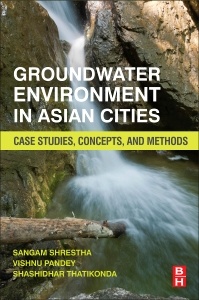Groundwater Environment in Asian Cities Concepts, Methods and Case Studies
Coordonnateurs : Shrestha Sangam, Pandey Vishnu Prasad, Thatikonda Shashidhar, Shivakoti Binaya Raj

Groundwater contributes to the sustainable development of many Asian cities by providing water for domestic, industrial and agricultural uses and regulating ecosystem flows. However, groundwater has not always been properly managed, which often has resulted in depletion and degradation of the resource. Groundwater Environment in Asian Cities presents the up-to-date scientific knowledge on groundwater environment in fourteen Asian cities using Driver-Pressure-State-Impact-Response (DPSIR) framework. In detail the book presents the facts and figures of groundwater dependency, problems related to groundwater over exploitation, implementation of various policy instruments and management practices and their results in selected fourteen Asian cities, namely; Bandung (Indonesia), Bangkok (Thailand), Beijing (China), Bishkek (Kyrgyzstan), Chitwan (Nepal), Delhi (India), Dili (East Timor), Ho Chi Minh (Vietnam), Hyderabad (India), Khulna (Bangladesh), Lahore (Pakistan), Seoul (South Korea), Tokyo (Japan), and Yangon (Myanmar). The book provides the one-step platform to get sufficient details about groundwater aquifers, hydrogeology, groundwater status, impacts on groundwater environment and responses (technology, policy, institutional, etc.) deployed in the case studies cities, and therefore, provides a snap-shot of Asian groundwater environments. The theoretical background of the topics discussed along with the case studies help the readers understand the similarities and differences about the status of groundwater development and use in each city. In addition, the information in the book will serve as a baseline for other research such as mitigation of groundwater related problems (e.g., land subsidence), impact of climate change on groundwater, and importance of groundwater for implementing sustainable development goals in future.
1. Groundwater as an environmental issue in Asian cities
2. DPSIR framework for evaluating groundwater environment
3. Water environment in South Asia: an introduction
4. Groundwater environment in Chitwan, Nepal
5. Groundwater environment in Delhi, India
6. Groundwater environment in Hydarabad, India
7. Groundwater environment in Khulna, Bangladesh
8. Groundwater environment in Lahore, Pakistan
9. Water environment in Southeast Asia: an introduction
10. Groundwater environment in Bandung, Indonesia
11. Groundwater environment in Bangkok, Thailand
12. Groundwater environment in Dili, East Timor
13. Groundwater environment in Ho Chi Minh, Vietnam
14. Groundwater environment in Yangon, Myanmar
15. Water environment in Central and East Asia: an introduction
16. Groundwater environment in Beijing China
17. Groundwater environment in Bishkek, Kyrgyzstan
18. Groundwater environment in Seoul, South Korea
19. Groundwater environment in Tokyo, Japan
Environmental and Civil Engineers; Researchers; Groundwater Scientists; Government and Non-Government Organizations
Dr. Pandey is a Research Fellow and Affiliated Faculty at Asian Institute of Technology (AIT), Thailand. Before joining AIT, he worked as a postdoctoral researcher for nearly three years University of Yamanashi in Japan and Research Faculty for nearly two years with Asian Institute of Technology and Management (AITM) in Nepal before joining AIT. Dr. Pandey has received several awards and fellowships and published over two dozen of peer-reviewed journal papers, several book chapters and conference papers. His recent books include “Climate Change and Water Resources and “Kathmandu Valley Groundwater Outlook. His core area of research interest and expertise is related to various aspects of groundwater characterization, assessment, and management. His publications related to groundwater include development of groundwater sustainability infrastructure index, evaluation of groundwater environment using DPSIR framework, analyzing hydrogeologic characteristics, estimating groundwater storage potential, and analyzing groundwater markets, among others. Dr. Pandey received B.Eng. (Civil) from Tribhuvan University (Nepal), M.Eng. (Water Engineering and Management) from AIT (Thailand) and PhD (Groundwater Management) from University of Yamanashi (Japan).
Dr. Shashidhar is an Assistant Professor of Department of Civil Engineering at Indian Institute of Technology, Hyderabad. He obtained Ph.D. from Indian Institute of Technology Madras in the year 2006. He was a visiting faculty at Asian Institute of Te
- Presents a framework for evaluating groundwater environment in urban environments
- Includes case studies and local examples from a broad geographical range of urban environments from virtually every region in Asia, including Bandung, Bangkok, Delhi, Bishkek, Beijing and Tokyo
- The book will be a valuable resource for groundwater adversaries in the scientific, decision-making and end-user communities, particularly for understanding and assessing state of groundwater resources in the region as well as learning from the responses practiced so far (Dr. Linda Anne Stevenson, APN)
- The contents in this book are very much useful for informed decision-making for protecting groundwater environemntand therefore contributes in making invisible visible (Dr. Neno Kukuric, IGRAC)
- With concrete examples and lessons for readers, this book responds to the call for comprehensive research and studies, the implementation of new science-based methodologies and endorsement of principles for groundwater resources management and cities (Dr. Aureli Alice, UNESCO-IHP)
- As a “Regional Hub for Groundwater Management in the Asia Pacific Region, IGES finds this book as a very much useful reference for knowledge hub partners, groundwater managers, academic institutions, research scholars, and international organizations working in the areas of groundwater in Asia and beyond (Dr. Hideyuki Mori, IGES)
Date de parution : 02-2016
Ouvrage de 542 p.
15x22.8 cm
Thème de Groundwater Environment in Asian Cities :
Mots-clés :
air quality; aquifers; climate; climate change; DPSIR; drinking water supply; economic development; environment issues; food security; geology; gross domestic product; groundwater; groundwater abstraction; groundwater environment; groundwater quality; groundwater resources; hydrogeology; industrial effluents; irrigation practices; land cover; land subsidence; land use; legal regulations; lowland plains; natural resources; nitrate pollution; overexploitation; physiography; population density; population growth; public health; recharge; salinity intrusion; soil degradation; subregional countries; surface water; topography; urbanization; waste disposal; water availability; water environment; water quality; water supply; water utilization; well statistics



